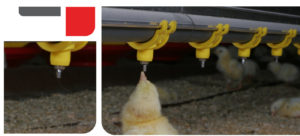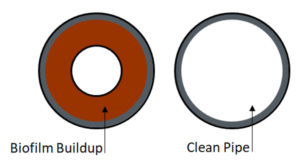Would you drink the water you give your birds?
Having clean, safe water is one of the most important factors in the health and performance of your poultry. It also affects egg quality and shell thickness for layers. But the simple fact is that your water supply is vulnerable to minerals, bacteria, algae and more, most of which you may not even be able to see.

The effects of contaminated water
The buildup of the bacteria-friendly ‘biofilm’ that grows inside your watering system causes many issues, including:
In short, contaminated water can increase the vulnerability and mortality of your flock. So, how do you protect against microbial contamination and biofilm buildup? Clearly, it’s not enough to pump in a clean source of water: your pipes need to be cleaned too.
Flushing out your water
One of the simplest ways to do this is to flush the nipple system, thereby washing away the elements that bacteria and other organisms feed off. You are probably doing this already, but are you doing it often enough? It is recommended that you flush your water pipes at least once per day, depending on the climate, house type and bird you are dealing with. We recommend flushing the lines one after the other to ensure that there is enough pressure for the flushing. Flush each line for 10 minutes at least to provide enough time to remove the scale buildup and the bacteria with it.
As well as ensuring the quality of water and the pipe system, flushing helps to maintain an ideal water temperature of around 20˚C (68˚F): chickens don’t like hot water, so if the water gets over 27˚C (81˚F), your flock will drink less, affecting their daily body weight. The heat will also encourage the growth of bacteria within the system, leading to all the problems mentioned above.

Making flushing simple
You may be put off frequent flushing because of the time, cost, water wastage and effort involved – top tier cages in particular can be tricky to reach. Recognizing these challenges, PLASSON with over 50 years of experience has recently completed the innovation development of a new, patent pending, Automatic Wireless Flushing Solution that washes out contaminated water, bringing in a boost of high pressure water that pushes out dirt, bacteria and air pockets, while cooling down the whole watering system.
The new pressure regulators design features an external connecter for improved flow, a choice of three flushing modes: manual, wired or wireless, and three options of sight tube: regular, threaded or detachable. It is easy to maintain, works on 24V and is available as a pressure regulator or pressure reducer.
The innovative wireless option is operated by Bluetooth, named FlushControl, and can be operated from a smart phone with a dedicated app. Each Line head unit can be controlled by a wall base unit with a control radius of up to 30 meters. The wall base unit can be wired to the house control unit. A wall base unit can simultaneously control up to 30 lines.
The Automatic Wireless Flushing Solution is an economical solution that requires no wiring across the house and minimal setup. Simply connect the system to the nipple line that the birds drink from, and use the app on your mobile or tablet to pre-set, change, modify, and switch to manual operation, quickly and easy.
To find out more about PLASSON’s FlushControl Automatic Wireless Flushing Solution, click here>

VIV Bangkok 2019
March 18-20, 2019